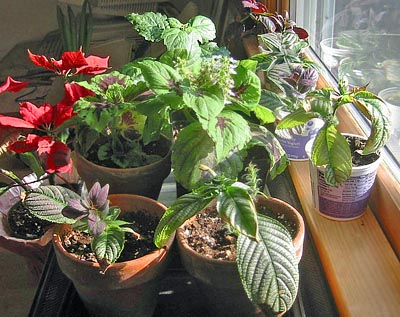Welcome back, Begonia!
Smart ways to invite plants in from the cold

Geranium cutting indoors for winter
Summer is over, your vacation is behind you, and so is the sojourn your houseplants enjoyed under the dappled shade of your maple tree. Just as you must resume your routine, so must your plants resume their indoor life when outdoor daytime temperatures dip below 60 and nights fall below 50-degrees.
The transition between outside and inside exposes plants to different light, temperature and moisture levels, and it will take some care on your part to minimize the shock they experience. Gather some essential supplies before you begin: First, you’ll need potting soil to refresh your plants–instead of garden soil or compost, which can contain bugs or diseases that you don’t want inside your house. Second, purchase insecticidal soap or horticultural or neem oil, in case you need to treat insects hitchhiking rides on your plants.
Now, get to work:
- Cleanliness counts.
If your pots have acquired any moss or mold, scrub the outsides with a mixture of one part household bleach with 10 parts water. If you plan to repot, scrub the containers’ insides as well. - Evict the bugs.
Leaf dwellers that attack plants include aphids, spider mites, scale and mealybugs. Insects often attach to leaf undersides, so check leaf tops and bottoms. Pay attention to the area where leaves join the stem, a good hiding place for bugs. Blast plants with water from your hose, making sure to hit the underside of the leaves and to use enough force to evict bugs but not tear foliage. You may want to invest in a special nozzle, available online and specifically made to send bugs surfing. - Treat ones you miss.
Once the leaves are dry, spray the plant with horticultural or neem oil or with insecticidal soap to smother any remaining insects or eggs. Unlike pesticides, these products are organic and safe to use, but be sure to read instructions carefully. The oils need to be applied in the shade and should not be used on certain plants such as African violets.> - Soil tactics.
Insects and other critters can dwell in the soil as well. To tackle these, fill a bucket with warm water and submerge the plant for 15 minutes. If you see ants, repot the plant to eliminate any eggs that could hatch later. Remove the plant from the container, gently wash the dirt from the roots, and repot with fresh potting soil. - Trial separation.
Isolate plants you have treated from healthy plants in your house for six weeks. Check the quarantined plants regularly to ensure the pests are gone. - Size up, if necessary.
Plant growth slows in the fall and winter, which usually means plants don’t need repotting during these seasons. However, if a plant has outgrown its container, become leggy or too big for its corner, you may want to prune or repot it. Do not remove more than one-third of the plant, and prune the roots and the top in equal proportions. - Slow and steady.Conditions inside the house differ from those outside, so acclimate plants gradually to avoid shock. Start by bringing them in at night for about two weeks so they can adjust to the different temperature and moisture levels. Leaves may turn yellow or drop as they adapt to the lower light, but they should grow back. Place plants near a window where they will receive the abundant light they enjoyed outdoors. Avoid placing a plant near a drafty spot or heating vent. If it must be near a heating vent, where the air will be dry, place the pot in a tray lined with pebbles and water, and mist the plant occasionally.

Cuttings from tropicals brought indoors
- Easy on the H2O.
Don’t overwater plants. Pots do not dry out as easily indoors, and as plants slow their growth, they will not need as much water. Put your finger in the soil, and if it still feels moist, hold back on watering.
References
• Bringing Houseplants Indoors, Department of Plant and Soil Science at the University of
Vermont Extension.